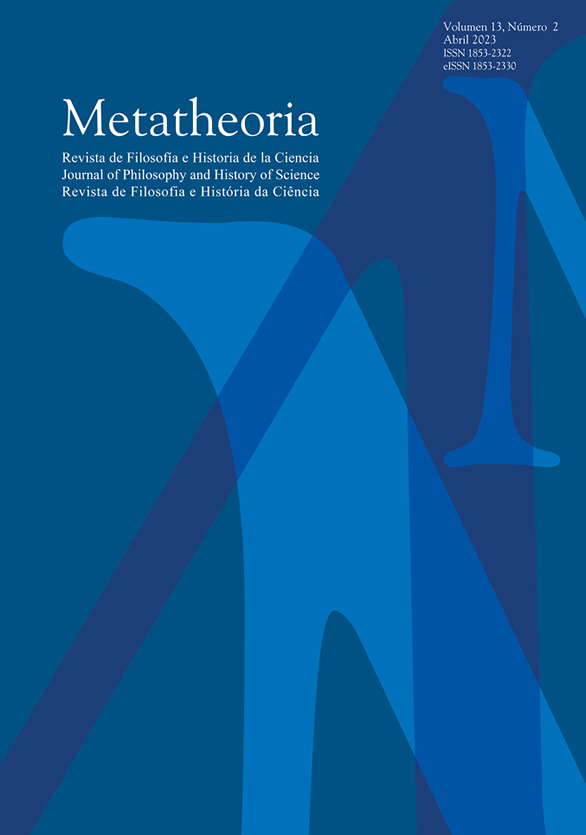Teleología: ¿ayer, hoy y mañana?
DOI:
https://doi.org/10.48160/18532330me13.334Palabras clave:
Charles Darwin, teleología, biología evolutivaResumen
Las explicaciones teleológicas en biología evolutiva, desde Cuvier hasta el presente (y hacia el futuro), dependen de la metáfora del ‘diseño’ para conservar su poder heurístico y su fertilidad predictiva.
Citas
Appel, T. A. (1987), The Cuvier-Geoffroy Debate: French Biology in the Decades Before Darwin, New York: Oxford University Press.
Bates, H. W. (1892), The Naturalist on the River Amazon, London: John Murray; first published in 1863.
Bowler, P. (1984), Evolution: The History of an Idea, Berkeley: University of California Press.
Browne, J. (1995), Charles Darwin: Voyaging, Volume 1 of a Biography, New York: Knopf.
Chambers, R. (1844), Vestiges of the Natural History of Creation, London: Churchill.
Clarkson, E. N. K. y R. Levi-Setti (1975), “Trilobite Eyes and the Optics of Descartes and Huygens”, Nature 254: 663-667.
Coleman, W. (1964), Georges Cuvier, Zoologist: A Study in the History of Evolution Theory, Cambridge, MA: Harvard University Press.
Cuvier, G. (1813), Essay on the Theory of the Earth (trans. by R. Kerr), Edinburgh: W. Blackwood.
Cuvier, G. (1817), Le règne animal distribué d'après son organisation : pour servir de base a l'histoire naturelle des animaux et d'introduction a l'anatomie comparée, Paris: Deterville.
Cuvier, G. (1830), “Considérations sur les Mollusques, et en particulier sur les Céphalopods”, Annales des sciences naturelles 19: 241-259.
Darwin, C. (1859), On the Origin of Species, London: John Murray.
Davies, N. B. (1992), Dunnock Behaviour and Social Evolution, Oxford: Oxford University Press.
Dawkins, R. (1983), “Universal Darwinism”, en Bendall. D. S. (ed.), Molecules to Men, Cambridge: Cambridge University Press, pp. 403-425.
Dawkins, R. (1986), The Blind Watchmaker, New York: Norton.
Dobzhansky, T., Ayala, F. J., Stebbins, G. L. y J. W. Valentine (1977), Evolution, San Francisco: W. H. Freeman.
Fodor, J. (1996), “Peacocking”, London Review of Books (18 April): 19-20.
Foucault, M. (1970), The Order of Things: An Archaeology of the Human Sciences, New York: Pantheon.
Geoffroy Saint-Hilaire, E. (1818), Philosophie anatomique, Paris: Mequignon-Marvis.
Gould, S. J. y R. C. Lewontin (1979), “The Spandrels of San Marco and the Panglossian Paradigm: A Critique of the Adaptationist Programme”, Proceedings of the Royal Society of London Series B: Biological Sciences 205, 581-598.
Hamilton, W. D. (1964a), “The Genetical Evolution of Social Behaviour I”, Journal of Theoretical Biology 7: 1-16.
Hamilton, W. D. (1964b), “The Genetical Evolution of Social Behaviour II”, Journal of Theoretical Biology 7: 17-32.
Hesse, M. (1966), Models and Analogies in Science, Notre Dame: University of Notre Dame Press.
Huxley, T. H. (1898), The Scientific Memoirs of Thomas Henry Huxley, 4 vols., M. Foster & E. R. Lankester (eds.), London: Macmillan.
Kramer, P. J. (1984), “Misuse of the Term ‘Strategy’”, BioScience 34: 405.
Lewontin, R. C. (1978), “Adaptation”, Scientific American 239(3): 223-230.
Maynard Smith, J. (1982), Evolution and the Theory of Games, Cambridge: Cambridge University Press.
Nagel, E. (1961), The Structure of Science: Problems in the Logic of Scientific Explanation, New York: Harcourt, Brace and World.
Nissen, L. (1997), Teleological Language in the Life Sciences, Lanham, MD: Rowman and Littlefield.
Owen, R. (1849), On the Nature of Limbs, London: Voorst.
Paley, W. (1819), Natural Theology, vol. 4 of Paley’s Collected Works, London: Rivington, first published in 1802.
Parker, G. A. (1978), “Evolution of Competitive Mate Searching”, Annual Review of Entomology 23: 173-196.
Richards, R. J. (1992), The Meaning of Evolution: The Morphological Construction and Ideological Reconstruction of Darwin’s Theory, Chicago: University of Chicago Press.
Ruse, M. (1977), “William Whewell and the Argument from Design”, Monist 60: 244-268.
Ruse, M. (1979), The Darwinian Revolution: Science Red in Tooth and Claw, Chicago: University of Chicago Press.
Ruse, M. (1982), Darwinism Defended: A Guide to Evolutionary Controversies, Reading, MA: Benjamin/Cummings.
Ruse, M. (ed.) (1988), Readings in the Philosophy of Biology, New York: Macmillan.
Ruse, M. (1989), The Darwinian Paradigm: Essays on its History, Philosophy and Religious Implications, London: Routledge.
Ruse, M. (1996), Monad to Man: The Concept of Progress in Evolutionary Biology, Cambridge, Mass.: Harvard University Press.
Ruse, M. (1999), Mystery of Mysteries: Is Evolution a Social Construction? Cambridge, MA: Harvard University Press.
Waddington, C. H. (1957), The Strategy of the Genes, London: Allen and Unwin.
Wallace, A. R. (1905), My Life: A Record of Events and Opinions, London: Chapman and Hall.
Whewell, W. (1837), The History of the Inductive Sciences, 3 vols, London: Parker.
Whewell, W. (1840), The Philosophy of the Inductive Sciences, 2 vols, London: Parker.
Whewell, W. (1845), Indications of the Creator, London: Parker.
Descargas
Publicado
Cómo citar
Número
Sección
Licencia
LicenciaLos documentos aquí publicados se rigen bajos los criterios de licencia Creative Commons Argentina.Atribución - No Comercial - Sin Obra Derivada 2.5





